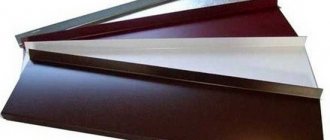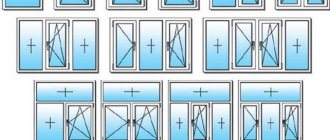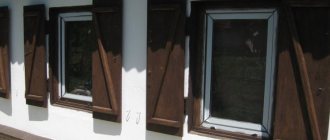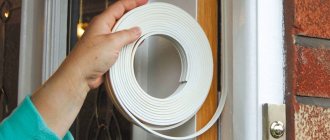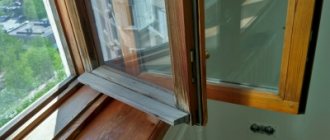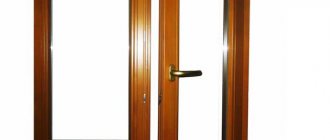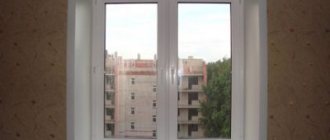Continuing the topic of thermal insulation of window and door structures using installation, we have determined that the most convenient, effective “protector” is polyurethane foam. At the same time, its “protection” will work if the foam is covered with additional special materials that will perform the functions of protecting moisture permeability, vapor permeability and insulating the foam from ultraviolet radiation.
Also, when installing structures, it is necessary to maintain installation gaps, otherwise the “dew point” will shift and no matter how good the materials are, they will not work to their full potential.
But everything is in order.
Let's look at GOST and see that all materials used during installation must meet certain standards.
Let's read the Technical Requirements section and pay attention to Table 2 - Recommended mounting clearance dimensions.
Installation gaps must be maintained depending on the material of the structure being installed. They are different for different types of structures - this is due to the properties of the materials of the manufactured product. In particular, with such a property as compression-expansion under the influence of heat and cold.
The gap between the wall and the window, the so-called installation seam, after fixing the window in the opening during installation, is filled with polyurethane foam.
Let's move on to protecting the foam from external influences (heat, cold, rain, wind, sun). We have two layers of protection. One from the outside of the building (outer layer), the second from the side of the room (inner layer):
- external – waterproofing (diffusion tape), vapor-permeable (PSUL tape);
- internal – vapor barrier (duplicated and metallized tapes).
Let's look at how protection works using the outer layer.
The mounting foam on the outside must be protected from the sun (it is destroyed by ultraviolet rays) and rain, i.e. water (which impairs the durability and thermal insulation of the polyurethane foam, and destroys it when it freezes), but at the same time, the external protection of the mounting seam must be vapor-permeable, that is, water condensate that forms in the pores of the polyurethane foam, during the transition from cold to heat, must be discharged outside to prevent the foam from getting wet and breaking down. To solve these problems, PSUL tape is used.
PSUL tape
PSUL is a pre-compressed self-expanding sealing tape
used for sealing seams. When installing products in an opening, PSUL fills the gap between the window frame and the wall opening. It is designed to fill any gaps, within the limits of standards, in construction and is a strip of porous elastic material resembling foam rubber with special impregnations. The tape is made from modified acrylic and polyurethane. Acrylic impregnation slows down aging and extends the service life of the seal. For ease of use, PSUL tape has an adhesive mounting layer on one side.
Color black or grey. It is produced in a compressed state in rolls with protective tape attached. PSUL expands under the influence of moisture in the air. The purpose of PSUL is good waterproofing with guaranteed vapor permeability, protection from ultraviolet rays and high durability in conditions of various deformations of the window profile relative to the wall opening.
Polyurethane foam is weather-resistant, but PSUL is not.
From the inside, the foam of the assembly seam is closed completely hermetically, providing complete vapor barrier to the seam and completely eliminating the penetration of moisture into the seam from the room. For this purpose, special vapor barrier membrane tapes are used. We'll look at this below.
But not everything is so easy and simple.
The main disadvantage of installation using PSUL is that the width of the external gap between the front surface of the frame and the opening must be maintained in the range from 3 to 15 mm. This is due to the fact that when the PSUL tape expands beyond the specified normalized values, its waterproofing ability decreases. The tape itself expands to 40-45 mm (a fivefold increase in thickness is possible). But this is a completely non-working tape and it will not perform its functionality. Therefore, you should not believe what installation organizations sometimes say about the operation of the tape no matter how wide it is.
When removing the protective packaging and sticking the PSUL onto the working surface, the tape expands to operational working dimensions (discussed above). Then, it is desirable that the PSUL fully expands before the installation seam foams. Penetration of foam behind the PSUL tape is unacceptable. The time for complete expansion of the PSUL directly depends on the ambient temperature; for example, at 10 °C, expansion can take 15 hours or more. You can use the option of gluing an already expanded PSUL tape, but then it is necessary to press the frame to the quarter with clamps, which also complicates installation and, thus, can reduce its quality (this option is not recommended when changing products).
PSUL tapes come in different sizes, both in width and in the size of the “working” extension.
It is necessary to select the correct size for each specific installation of a translucent structure.
As a result, we received positive qualities of PSUL:
- easy to use during installation
- it is very plastic and thanks to this it can fill any cracks and gaps.
- allows water vapor to pass from the house to the outside
- UV and aging resistant
- resistance to heavy rains up to 600 Pa
- takes any shape
- and most importantly, the PSUL tape is not covered with anything, either plaster or any other material. This is simply not required.
PSUL tape is used for sound insulation of steel castings
tape layout diagram
PSUL sizes
PSUL tape for plastic windows is available in several dimensional grids and wound into a roll. The length of one bundle can be from 3 to 15 meters. It depends on the thickness of the material. Size is calculated in several states:
- width of the adhesive surface (from 10 to 20 mm);
- thickness in the original (compressed) state (4, 6, 8, 10 mm);
- maximum expansion in a free state (20, 30, 40, 50 mm).
One Velcro tape can fill a seam from 3 mm to 2 cm. For large areas, 2 tapes can be used in parallel. However, to maintain an acceptable level of insulation, the gap thickness should not exceed 4 cm.
In addition to size, the expansion coefficient is of great importance. The higher it is, the less dense the seal is. It is not capable of providing a reliable degree of insulation over the long term. The expansion coefficient when working with PVC should not exceed 30%.
Diffusion tape
Go ahead. On the street side, to cover the foam, another vapor-permeable tape is used, which protects the mounting foam under low tide and it is installed under low tide. Its name is diffusion tape.
Diffusion moisture-proof vapor-permeable tape NL is made of membrane-type synthetic non-woven material and is intended for waterproofing the lower assembly seam (under the ebb) from external moisture, as well as any other joints and construction seams when installing structures.
The tape has two adhesive butyl rubber strips on one side:
- one strip is intended for gluing the diffusion tape to the product,
- the other is for gluing the tape to a wall opening or slope.
There are enough standard sizes of tapes to choose it for almost any size.
Treatment of the installation seam with diffusion tape provides reliable protection of the installation foam from the penetration of moisture from the outside into the room and, at the same time, ventilation and removal of moisture from the insulation (foam) of the installation seam.
Diffusion vapor-permeable tape is adhesive to different surfaces.
- Resistant to direct sunlight for up to 8 months
- withstands pressure up to 600 Pa
- vapor permeability coefficient not less than 0.15 mg/(m h Pa)
- operating temperature from -50° to +100° C
- chemically neutral
You can read how diffusion tape is used in the article Installation of ebb tide.
What is PSUL for windows, what is it for?
Externally, the PSUL tape (pre-compressed seal) resembles thinly cut foam rubber in gray or black. In fact, it is made from compressed polyurethane foam placed on both sides on a self-adhesive backing. In order for the material to acquire vapor barrier properties, it is impregnated with special compounds based on neoprene or acrylic.
It is noteworthy that the gray seal is considered more reliable. It has improved insulating properties and lasts longer.
Compressed polyurethane foam begins to self-expand under the influence of heat and completely fills the seam between window or door openings. PSUL for windows allows not only to hide surface unevenness.
The use of the material provides:
- protection against condensation;
- increased sound insulation;
- a barrier from dust entering the room;
- uniform distribution of polyurethane foam, creating an obstacle to its exit;
- protection from sun, wind and cold;
- aesthetic appeal of the seam from the street side.
PSUL tape reliably protects the polyurethane foam from adverse environmental factors (wind, ultraviolet radiation, precipitation), under the influence of which it gradually decomposes. Open seams absorb and retain moisture, which is why the material begins to deteriorate over time. Poor insulation leads to increased heat loss.
Dubbed tape
What is a dubbed tape?
This is an elastic vapor barrier tape, which is made of butyl rubber and backed with non-woven fabric (spunbond) with a self-adhesive mounting strip for attaching to products, which has a high degree of adhesiveness. The tape isolates the installation joint from the penetration of moisture from the air from inside the room, and also prevents condensation from escaping from the joint into the room and onto slopes, preventing the formation of mold and mildew on the inner surface of the joint.
It is used for noise and heat insulation of junction points during the installation of structures. Available in rolls with widths from 75 mm to 200 mm. Self-adhesive butyl rubber layer, with the help of which the tape is glued to the structure and wall opening (slope), protected with anti-adhesive film or paper.
How is duplicated tape used?
The tape does not require additional preparation or special tools and is immediately ready for use. The surfaces of seams and joints must be cleaned of dirt. Weak and absorbent surfaces must be primed first. The duplicated tape must be glued tightly along its entire length.
Installation of the tape should be carried out using the “from the frame” technology, having previously glued it to the frame of the product. The tape must be overlapped. It is recommended to seal the assembly seam “on the wet foam”. This is necessary so that the polyurethane foam, when expanding, sticks the tape to itself and stretches it a little for more convenient work during subsequent plastering of the slopes. The use of duplicated vapor barrier tape in the installation seam is a guarantee of its reliable and long-term operation. This insulating layer protects the insulation (foam) of the assembly joint from premature destruction and aging, since it has high vapor permeability. To finish the diffusion tape, you can use various materials, both dry and wet plastering.
The conditional service life of duplicated tapes is more than 20 years.
Let's move on to the last insulating tape used to protect the polyurethane foam - this is a metallized tape that is glued under the window sill.
Mounting tapes for windows
The key aspect in installing windows is reliable sealing, ensuring normal temperature in the room and preventing the entry of dust and dirt from the street. To do this, installers use various self-adhesive tapes for windows, which fill the voids and ensure a complete and tight fit of the window to the frame.
The Yutura online store offers a wide range of products for window installation, including mounting, vapor barrier tapes and PSUL at affordable prices in Yekaterinburg and the Sverdlovsk region.
- Wholesale price: 363.45
- Price unit: r.
- Country of manufacture/Brand: Utura
- Wholesale price: 368.97
- Price unit: r.
- Country of manufacture/Brand: Utura
- Wholesale price: 392.85
- Price unit: r.
- Country of manufacture/Brand: Utura
- Wholesale price: 400
- Price unit: r.
- Country of manufacture/Brand: Utura
Metallized tape
Insulating vapor-proof metallized tape is made on the basis of non-woven fabric coated with aluminum foil or metallized film reinforced with high-strength synthetic thread. The tape has two butyl rubber strips on one side. One strip is intended for gluing the tape to the product, the other is for gluing the tape to the slope of the wall opening. On the side of the strip intended for fastening to the structure, the tape is duplicated with non-woven material to create adhesion of the tape with the plaster mortar. The presence of non-woven fabric allows you to create adhesion of the tape with plaster mortar or polyurethane foam
The tape is intended for internal hydro- and vapor barrier of assembly joints, followed by possible plastering and installation of the window sill.
Metallized tape is produced in rolls with a width of 75 mm to 200 mm and is used depending on the width of the gap between the window opening and the frame. Self-adhesive butyl rubber layer, with the help of which the tape is glued to the structure and wall opening (slope), protected with anti-adhesive paper or film. The tape is sold in rolls.
The use of metallized tapes provides high protection of the foam from moisture from the side of the building and prevents moisture from escaping from the seam on the surface of the internal slopes.
Materials used
For window installation
uses only high-quality materials from leading manufacturers:
VETONIT
is a frost-resistant dry mortar on a gray cement base, consisting of quick-hardening Portland cement, natural sand with a fraction of 0.6 mm, and special additives that improve weather resistance and workability, with a strength of more than 20 MPa. It has good vapor permeability and, combined with high frost resistance (operating temperatures -35° - +50° C), is an excellent material for sealing external seams
ROTBAND
— a universal dry plaster mixture based on gypsum with polymer additives that provide increased adhesion. Gypsum dry mixes can come in a variety of colors, from white to gray and even pink. This is due to the presence of natural impurities in gypsum stone. The color of the mixture does not affect its characteristics in any way. Designed for high-quality plastering of ceilings and walls with a conventional solid base, for example, concrete, brick, cement plaster, as well as surfaces made of polystyrene foam, DSP. Particularly recommended for smooth concrete ceiling and wall surfaces. Can be used for finishing rooms with normal humidity, as well as in kitchens and bathrooms. Has the necessary level of vapor barrier for use as an internal layer of protection for an assembly seam
Rules for slope insulation
Important! Before gluing the tapes, the working surface of the assembly joint must be cleaned of dust (with a brush), dried from moisture, leveled where there are large holes and depressions (trowel), in winter - a must! – from frost, snow and ice. If the surfaces of the window opening are damaged, they must be restored. It is recommended to carry out installation work down to –20°С, and it is necessary to pre-condition the tapes and foam in a room (+20°С). When installed in an opening, mounting tapes do not require special tools.
- The polyurethane foam will be reliably protected if high-quality materials from trusted manufacturers are used during installation
- the openings of the room will be prepared, i.e. cleaned of dust, dirt and leveled (restored) so that there are no holes or bulges
- mounting tapes will work if the mounting clearances are observed
- Mounting tapes must be glued tightly along their entire length. The tapes must be joined end-to-end (PSUL) and overlapped (diffusion, duplicated, metallized)
- mounting tapes must be glued in a certain sequence (outer tapes are glued to the frame before installing the product in the window opening, internal ones - after foaming the gaps)
PSUL tape for windows - what kind of material is it? PVC window installers know that this is a pre-compressed sealing strip. It is an integral element of high-quality installation of plastic and wooden windows.
This material cannot be classified as innovative, since it has been used for more than two decades. But new modifications of PSULs appear regularly, claiming to be the most reliable and high-quality ones.
How to work with tape
All characteristics and advantages of the tape will be valid only if specialists adhere to the specified technologies when using the material. If you do not follow the rules and instructions, then the service life is reduced, the rate of destruction increases, etc.
It is better not to use PSUL yourself, despite the apparent ease of installation. However, if you still plan to act on your own and not turn to professionals, then follow the instructions:
- Thoroughly clean the butt seams from dust, dirt and various debris. It is advisable to do this with a brush, since rags have lint, which can only aggravate the situation.
- Treat the surface with special disinfecting soil solutions. Wait a while until the primer is thoroughly absorbed. The exact waiting times are indicated on the packaging or container with the composition.
- Cut 1 cm from the roll of tape. This piece is located on the outside, so it is probably damaged and cannot be used.
- Measure the places that need to be sealed. Cut the required amount of tape from the roll. It is advisable to have 1-1.5 cm in reserve.
- Remove the protective film from the tape at a distance of 3-4 cm. Next, the tape itself is attached to the surface of the structure. When 3 cm is fixed, you can remove the protective film further. You cannot immediately remove the protective film along the entire length of the material in question.
- The PSUL is fixed first on the vertical parts of the opening, then on the horizontal ones.
- Leave the seal while it expands. The timing depends on the current outside temperature. If the installation is carried out in winter or late autumn, many specialists prefer to use a special construction hair dryer to speed up the process.
After the tape has expanded, you can proceed directly to the installation of window blocks. In some cases, consumers refuse to use this material precisely because the installation time for window structures increases several times. But the use of such material guarantees durability and quality.
Why do you need PSUL tape?
The purpose of sealing tapes is to eliminate gaps and protect assembly seams. At the dawn of the appearance of plastic windows, when installing them they used (and still use) self-expanding foam. The practice of using this sealant has shown that it can be destroyed under the influence of temperature changes, moisture and ultraviolet radiation.
An active search for a new means of eliminating gaps and protecting polyurethane foam led to the invention of a simple and reliable material - PSUL tape for plastic windows. Its characteristics significantly exceeded the capabilities of polyurethane foam. Since then, window installation technology has involved the use of PSUL. What is it good for?
- Has the ability to self-restore its shape.
- Retains a high degree of elasticity throughout its service life.
- It is a reliable barrier to the development of fungus and mold.
- Has excellent vapor permeability.
- It is an effective heat insulator.
- Capable of removing moisture beyond the assembly seam.
Despite the wide range of manufacturers of these tapes, they all have the same properties and are made from almost the same materials, with minor changes in the basic composition.
The basis of the seals is polyurethane foam elastomer, saturated with a composition based on acrylic resins. The density of polyurethane foam largely determines the technical characteristics of the finished product. The manufacturer can give his product any color, but this will not affect the quality. Therefore, when choosing a product, its color should not be the determining parameter.
The first manufacturer of PSUL is the German company Illbruck Bau-Technik GmbH. In Russia and the Commonwealth countries, the products of the following brands are mainly used:
- Profband (GiT LLC, St. Petersburg);
- "PSUL-EUROBAND" (Belarus);
- "Liplent" (Ryazan region);
- "Robiband" (Robitex, Moscow).
Fixing window installation errors with mounting tape
Hello, dear professionals!
Please help me solve this problem with windows. Instead of the old, drafty, Soviet ones, they decided to install plastic ones. I studied the issue, realized that the standard installation procedure offered by window manufacturers by foaming is quick and convenient for them, but for quality, a vapor barrier is necessary, and the window company asked to install it in accordance with GOST with a vapor barrier tape. I relied on the professionalism and integrity of the installer and got a disappointing result. During dismantling, naturally, the plaster crumbled, revealing masonry with potholes, crumbling cement and, in places, through cracks. Without any plaster, mounting tape was glued onto the dirty, embossed surface. A week later, when I had the strength and the opportunity to carefully examine the slopes, it turned out that there were through holes between the wall and the tape to the foam, and, in many places, it had completely separated from the walls. The plasterers say that they have never dealt with mounting tape before and don’t know how to plaster it. It seems to me that after dismantling the old windows, the master should have told us about the need to rough-plaster the openings for better adhesion of the foam and tape, and only then install new ones. So - the tape is damaged and does not fulfill its function, how the foam is connected to the wall is also a big question (in cold weather, during thermal compression, without reliable adhesion to the wall, cracks will form, with all the accompanying problems), how to plaster now is a big question. Please tell me: how all work of this kind should be carried out correctly and in what documents this is stated; what we can demand from the window company (complete reinstallation of windows in plastered openings or correction of mistakes made “on the spot”); how to plaster over tape with cement? Thank you very much! Masters online: 477 Orders per week: 1,430 Offers per day: 478
Hello, Natalia. Have you ordered “installation according to GOST” from window manufacturers? GOST for the installation of windows was, if I’m not mistaken, in 2003, then it was canceled, and the new one, as far as I know, was not adopted. So the very concept of “installation according to GOST” varies greatly from company to company. When installing houses, the selection committee needs something to build on, so they all refer to this GOST. Companies, especially those producing tapes, strongly promote their products to the masses, citing the canceled GOST. This is also beneficial for window companies - they get more money for installation. In reality, what happens is what happened to you: the tape does not stick, the plaster is completely torn off. The same GOST has requirements for the opening, so that it can then be mounted in accordance with GOST. Did you stand them? There I want to tell you many requirements for it. “You were not warned,” you say, but you also demanded installation according to GOST without particularly familiarizing yourself with it: in addition to the vapor barrier tape, there is also a waterproofing tape, PSUL, an exact spacing of fastenings and these fastenings must be fixed to the wall in a certain way, support blocks made of specified material and installed in the right places. You didn’t know this, but in the canceled GOST it is, and the company from which you ordered the installation wrote something else, at the same time there is no GOST in Russia... and what GOST are we talking about? what do you want to prove? that the film was poorly applied to you? and they didn’t warn you that the opening needed to be prepared? Well, they didn't warn me. and the main thing that they did not warn about is that you do not need this film, if you then plaster the slopes, all its properties will not work, because You throw a few centimeters of plaster on top, then paint. And from the street, my advice to you, plaster the joint between the window and the quarter - the PSUL will collapse in a few years or lose its properties, if you ordered it at all (since in order for it not to lose its properties, it must be of high quality and installed correctly - both are rare in Russia, and with an unprepared opening it is impossible). I won’t tell you how to plaster over tape with cement, but I don’t advise you to blame the window workers for your ignorance, although of course whether or not to blame is up to you. They, of course, could have advised, and even should have, and of course they didn’t do well that they didn’t explain this to you, but maybe... You wanted so much according to GOST that you didn’t listen... Is your opening closed? Is there a window to the level? Everything is working? Is it blowing anywhere? Then cover the installation seam on both sides with the required plaster and you will be happy. ) Sincerely, Dmitry Yelinevsky
Technical characteristics of PSUL tapes
If you compare the technical characteristics of seals from different manufacturers, you will find that all of these products, despite the difference in brands, meet the requirements set for them.
All enterprises strive to produce competitive products, so you can buy any sealing tape to install windows yourself. She is guaranteed to complete her task. Any Psul tape, the technical characteristics of which correspond to those given below, will serve faithfully for at least 20 years.
- Expandability from 10 to 70 mm.
- Presence of an adhesive layer.
- Resistance to temperature changes (operating range from -50°C to +70°C).
- Deformation under mechanical influence is no more than 15%.
- UV resistance.
- Vapor permeability in a compressed state is no more than 0.25 m2∙h∙Pa/mg.
- Neutral to chemicals.
- Resistant to moisture, therefore painting with vapor-permeable water-based paints and varnishes is allowed.
How to choose the right PSUL tape for plastic windows
In order for the tape to reliably seal the seam, you will have to choose the right size. Otherwise, noise, moisture and heat insulation will be compromised. Water will begin to accumulate in loosely fitting material, causing premature wear. In some cases, the PSUL may be squeezed out by mounting foam or pulled out in strong winds.
Rules for choosing a sealing self-expanding tape:
- To seal window seams, do not use tape smaller than 20 mm. Its thickness is not enough to tightly close the joint. The result will be moisture accumulation, leaks and premature aging of the tape.
- It is better to take the thickness of the compressed seal about 8 mm. It is enough to eliminate a standard window gap of 8-13 mm. For larger seams, use a tape with a thickness of 10. Small cracks of 4-6 mm are insulated with a 4 mm PSUL.
- The width of the adhesive layer should be selected based on the dimensions of the window or other surface to be sealed. Insufficient area of the adhesive area will make the structure fragile to external factors.
- Buy material from trusted manufacturers. It is better to give preference to European brands. Although domestic tapes are cheaper, the risk of running into a fake is higher. Therefore, before purchasing, you should ask the seller for a quality certificate for the seal.
Regardless of brand or size, the tape takes time to expand. It depends on the ambient temperature. For example, in 30-degree heat it will take on the required dimensions in half an hour, and at zero it will take up to 2 days.
Please note that only a new roll of tape can be used to seal gaps. After opening, the PSUL expands and becomes unsuitable for use.
Application area
PSULs are sold in rolls (reels), which ensures ease of transportation and use. These seals are produced in widths from 10 mm to 40 mm to protect seams of different sizes. At the request of the customer, manufacturers are ready to make tapes of any standard sizes.
The scope of application of seals is wide. They are used to protect assembly seams when installing metal, plastic, wood, and glass structures into concrete, wood and brick openings. Required for the following types of work:
- when installing windows and balcony blocks as a sealant and heat insulator;
- when installing thresholds and window sills;
- when installing roofing structures as damper joints;
- when installing ventilation and air conditioning systems to eliminate gaps, noise and vibration;
- during the construction of building structures to seal joints and as a sound and heat insulator.
The pre-compressed self-expanding sealing tape can have two adhesive sides. One is for fixing the translucent structure to the plane, the second is for attaching to the slope.
For what purposes can PSUL be used?
Initially, PSUL was developed for sealing external construction seams in a three-layer insulation system. It meets the requirements of GOSTs regarding the installation of window units, since it fully protects the seams from atmospheric influences and prevents the evaporation of moisture from them. But in practice, the scope of application of the material is much wider:
- Sealing of external joints of window and door blocks.
- Sealing the seams of shop windows, stained glass windows and other building elements.
- Sealing joints of slate, tiles, metal tiles.
- Closing cracks on facades and interpanel joints in concrete structures, wooden buildings, houses made of sandwich panels and calibrated timber.
- Sealing joints in drains, ventilation lines, etc.
PSUL allows you to protect seams with a width of 3 to 20 mm. If several tapes are used at once, the size of the compacted cavity increases to 40 mm.
PSUL hides the mounting foam and improves the appearance of the window unit
Installation technology
The PSUL, placed in the seam, gradually increases in volume, filling all the gaps. But this does not happen instantly. It takes time to expand. The speed of filling the seam directly depends on the ambient temperature. For better installation quality, it is not recommended to use PSUL at temperatures below -5°C.
For the installation of plastic windows, the self-expanding sealing tape PSUL “Robiband” is recommended. Products of this brand have long established themselves as high-quality and reliable.
According to GOST 30971-2002, when installing windows, it is required to provide a protected installation seam. This can be done using PSUL. To install the tape, perform the following steps:
- measure the width of the seam formed between the window opening and the window block;
- determine the location of the seal on the window frame;
- check the deviations of the opening walls vertically and horizontally (in this way they obtain information about the expected width of the gaps);
- using a pencil and a ruler, mark the location of the seal on the window frame;
- remove the packaging film from the roll and cut off 3-5 cm from the end of the tape;
- remove the protective paper from the adhesive side and glue the tape along the previously made markings on the window frame;
- gradually move along the box, gluing the seal around the perimeter;
- A larger sealant is glued to the wider seams;
- at the corner joints of the box, each strip of tape should hang down by 1-2 cm;
- the joined sections are bent and pressed against each other;
- install a frame with a seal in the window opening;
- strengthen the frame with self-tapping screws.
If a plastic structure is installed, the surfaces are pre-degreased. You can use White Spirit. If the expected gap width is 4-5 mm, use tape with a 20 mm extension. If the gap is more than 6 mm, a PSUL with a 30 mm extension will be required.
Have you decided to install ready-made plastic or wooden windows with double-glazed windows yourself? Let us warn you right away: self-installation has its own tricks that humanity has developed to insulate and seal wooden windows in wooden houses.
Inexpensive plastic windows for a summer residence have their own installation specifics! And dear ones too! Let's consider advanced solutions for sealing the junction of a wall and a window using PSUL tape
Installation of PSUL tape
Installation requires scissors, hair dryer (in cold weather), solvent and primer. The seal is attached to a clean surface. It is first cleaned of dust and degreased with a gasoline-based solvent (BR-1 or BR-2). If you need to attach the tape to a rough, abrasive surface, it is primed 2-3 hours before installation.
Installation technology:
- Measure window (door) openings.
- Open the roll of self-expanding sealant and cut 3 cm from the edge with scissors. This technological allowance has reduced adhesiveness. Using it will worsen the insulation. Over time, moisture will begin to seep into the resulting cracks, softening the mounting foam and breaking the seal.
- Measure and cut the required amount of tape, not forgetting to allow an allowance of 1 cm on each side of the height. A 1.5-centimeter increase is made in width.
- The adhesive side of the PSUL is attached around the perimeter of the insulated profile. 3 mm retreat from the edge. They do not bend the corners, but cut off the seal and glue it end-to-end, at an angle of 90 degrees. For fastening, a good fit to the surface is required. This is achieved by pressing down with your palms for 5 seconds.
- During installation, do not tighten the tape too much. Because of this, it will begin to expand worse and will not reach the values declared by the manufacturer. After installation, excess length may remain, but not more than 1 cm per 1 meter of material.
- Allow the PSUL to fully expand and install the window block in the opening, and fill the gap with polyurethane foam.
When installing the tape in cold weather, it is recommended to keep it for a day at room temperature (+18 +25 degrees), or preheat it with a hairdryer. This will help shorten the expansion period of the seal.
Sealing plastic windows in old houses has certain specifics. The facade into which the installed PVC block rests is rarely even. During the dismantling of old frames or over time, potholes, dents and bends form on the walls, making the gap in some places larger than the maximum permissible values. As a result, installation time increases, and often additional plastering and leveling of the walls is required.
The video clip describes in detail the process of sealing a plastic window with PSUL tape:
Innovative solution with PSUL tape
What is PSUL tape - it stands for pre-compressed self-expanding sealing tape.
PSUL is a self-expanding tape made of polyurethane elastic foam, which is impregnated with a mixture of modified acrylic. It significantly improves the properties of polyurethane seals, increasing their resistance to aging. The tape comes to the market in a compressed state, rolled into rollers. The sizes of the sealant come in different sizes, so it can be matched to any seam. PSUL tape for windows has a layer of adhesive on the surface, which simplifies its use. In addition, this prevents it from moving. Heavily compressed film expands only after the packaging is removed. A fivefold increase in thickness is possible.
PSUL for windows has many positive qualities - it is very elastic, can take almost any shape, is resistant to ultraviolet rays and heavy rain, and perfectly ensures the release of water condensate from the product into the atmosphere. Thanks to its plasticity, it can fill any gaps. PSUL tape can be used with almost any building materials: concrete, brick, steel, wood, plastic and other materials.
At the same time, PSUL has good moisture permeability: it will not prevent steam from leaving the house outside. GOST 30971-2002 prescribes the use of PSUL in residential construction. But when constructing or restoring a dacha, GOST recommendations are usually forgotten. The purpose of this article is to remind them. And if you have custom-made wooden windows installed at your dacha, help ensure that the contractors also do not forget about GOST.
PSUL tapes have the following characteristics:
PSUL tape in packaging and after expansion
- resistance to precipitation;
- resistance to ultraviolet rays (sun);
- resistance to moisture and wind under pressure (up to 600 Pa);
- has high adhesion and flexibility.
- PSUL also protects the foam (installation seam) on the street side from environmental influences.
PSUL is a self-adhesive polyurethane foam tape impregnated with a special neoprene compound. The tape is supplied compressed and rolled into rolls. A wide range of standard sizes of tape sealant allows you to choose the material to protect seams of the size. There are two types of PSUL tape: gray and black. The tapes differ slightly in characteristics and type of impregnation. Gray tape has better performance. The tape placed in the seam expands independently, completely filling all irregularities and voids, providing reliable protection of the seam from all adverse climate influences.
The use of PSUL tape complies with GOST 30971-2002 “Installation seams of joints connecting window blocks to wall openings.”
PSUL size 15x40-6m Explanation: width of the adhesive layer - 15 mm, maximum expansion 40 mm, length of the tape in the roller - 6 meters.
PSUL tape for windows - pros and cons
PSUL, pre-compressed sealing tape, is a product made of polymer materials.
It is polyurethane foam impregnated with modified acrylic. It is produced in the form of a tape with, on one side, an adhesive base. This design simplifies the process of installing the product on a sealed base. PSUL packaging is a roller with a reel containing pre-compressed tape. Its expansion occurs when external connections are removed, that is, unpacking. The requirements for an expanding product are set out in GOST 30971-2002. The main technological property of the product is the ability to increase in volumetric dimensions, filling the existing gaps.
- Scope ↓
- Pros and cons, properties of PSUL ↓
- Installation technology ↓
- Step-by-step instructions ↓
- Manufacturers ↓
- Cost ↓
PSUL tape on windows: a double-glazed window for a summer house increases its service life!
The main difference between new window technologies and old ones is the widespread use of polyurethane foam. It is with its help that PVC windows for dachas are installed in our time: it secures it, keeps heat out of the house, and is a jack of all trades. There is only one problem: when wet, polyurethane foam loses its beneficial properties. And no amount of old-fashioned platbands, canopies and moss pads will save you here: if the foam is not soaked by rain from outside, it will be saturated with steam from inside the room.
Places for installing PSUL tape to the box
Bottom line: after two years of operation of windows, 2-3 times more heat is lost through the wet mounting foam between the frame and the wall than through the double-glazed window, sashes and frame combined!
Where to buy and how much does it cost?
PSUL tape framed by frame
Whether you install ready-made plastic windows for your dacha yourself, or a contracting organization installs custom-made windows for your dacha, you will most likely have to buy PSUL tape yourself. There is no need to be afraid of this: compared to the current price for dacha windows, the cost of PSUL will pleasantly surprise you. For example cost:
- a tape with dimensions 10x20x15 (the first number is the width in mm, the second is the thickness after swelling in mm, the third is the length in m) made in Estonia costs 186 rubles;
- 15x40x8 – 200 rub.;
- 20x40x8 – 230 rub.;
Types and prices of PSUL tape
Prices are given according to the price list of the online store imperstroy.ru, not for any advertising reasons, but for reasons of practicality: ordering only sealing tape via the Internet is expensive - delivery will be more expensive than purchase, and on this site you can buy many more useful things in summer cottage construction : shutters for windows in the country house, bars for windows in the country house, curtains for windows in the country house, etc.
Read about how to insulate a plastic window with your own hands here: https://oknanagoda.com/okna/plastik/uteplenie/uteplit-plastikovoe-okno.html
Where to order a plastic window? The answer to this question will be told to you by the rating of Moscow window companies
The article “Flats for plastic windows - description, prices” will tell you about another way to protect the polyurethane foam around the window from adverse weather conditions
How to choose?
Installation diagram of pre-compressed sealing tape
When selecting a PSUL, two things should be remembered:
1. The tape is sold already compressed. When swelling, its thickness will increase approximately 5 times. That is, the tape, which was 4 mm when purchased, will expand to 20 mm after installation.
Measure the gaps that you need to cover and select
A special feature of PSUL is the presence of a self-adhesive surface
a tape that will really seal the contour and not flutter in the gap between the window block and the wall.
2. When installing the PSUL, it is not recommended to bend it. It is better to cut it into pieces equal to the sides of the opening to be sealed, and stick the tape so that its sections meet each other.
Please also note that the rate of increase in the volume of PSUL depends on the ambient temperature. At 30°C, complete expansion of the tape will occur in 30 minutes, at zero temperature - in several hours. Therefore, when installing windows in the cold season, the PSUL should be warmed up after installation. For example, a hair dryer.
Buy with reserve. Don't be afraid of what will remain. With the help of PSUL, tiled roofing and non-pressure pipes (for example, storm drains) are also sealed.
Procedure for working with sealing tape
Gluing PSUL to the window frame
Installation of pre-compressed sealing tape occurs as follows:
The PVC window and window opening are prepared for installation. To do this, dirt and loose plaster are removed, the surface is cleaned of dust using a vacuum cleaner, and wiped with a damp cloth. It is recommended to treat the surface of joints and seams with a special dust-removing compound.
The surface of the quarter is coated with an acrylic primer for exterior use. Markings are made and fasteners are installed. A few centimeters (3–5) from the beginning and end of the roller are cut off and not used. A piece of sealant is cut to the required length and the paper layer is removed. The tape is installed on the outside of the frame facing the street, with a distance of 3–5 mm from the outer edge of the quarter. The product is pressed to the surface. PSUL tape: technical characteristics, GOST
The PSUL is glued end-to-end, there should be no overlap. Vertical seams are filled without interrupting the tape at cross joints. Do not bend the seal at the corners.
After filling all the gaps between the window and the wall, you must wait until the tape expands to its free state. The rate of increase in the thickness of self-expanding material to working condition:
- at a temperature of 0°C the tape expands to the optimal size in 48 hours;
- at an outside air temperature of +18–20°C, the expansion process lasts 2–3 hours;
- at +30°C expansion occurs in 0.5 hours.
Features of the work
Firstly: the inner surface of the quarter, as a rule, has shell gouges and other damage. Secondly: the width of the external gap A between the front surface of the quarter frame, closed by the PSUL, is strictly defined for a given standard size of tapes. As a rule, inexpensive PSULs with a gap A of 3-5 mm, 6-10 mm are used. When the PSUL expands beyond the standardized values, their waterproofing ability decreases. It follows from this that it is necessary to putty and bring the inner surface of the quarter as parallel as possible to the window frame. Flaws. Unfortunately, our builders, both in the past and now, rarely indulge us with smooth openings. In brick houses, this is also supplemented by the need to seal the joints between the bricks. All this requires plastering and removing the inner surface of the quarter. This is labor-intensive and low-tech, especially in winter. Installation of a special vapor-permeable waterproofing tape under low tide
Features The tape is glued under low tide with one side to the window sill profile and the other to the bottom of the opening. It is necessary to very carefully waterproof the installation seam in the lower corners of the window opening. It is these places, as logic dictates, that are most critical for waterproofing. Rainwater flowing down the vertical surfaces of the assembly seam exerts maximum pressure at the junction of the ebb and the quarter.
Flaws . The importance of additional sealing at the junction of the flashing (waterproofing tape under the flashing) and the vertical PSUL is not emphasized.
The need to install a waterproofing tape under low tide is generally questionable, because low tide was invented for waterproofing. It does not prevent steam from escaping from under it. The junction of the waterproofing tape with the vertical PSUL is also leaky, like that of the ebb. Probably the most technologically advanced method of waterproofing in this area is the use of special sealants. They must have good adhesion to the joint materials, not destroy them and, most importantly, be durable when exposed to ultraviolet radiation. From all of the above, it follows that window installation using PSUL sealing technology works 100% only in ideal or specially prepared plastered openings. For greater clarity, we recommend watching the video.

